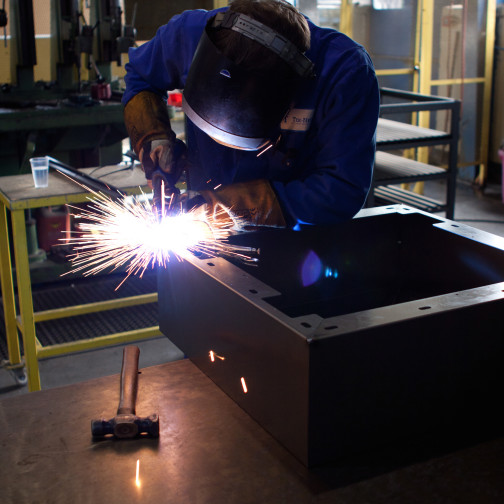Welding
At Tek-Neek we offer both TIG and MIG welding and have dedicated and experienced staff that work to a high standard on all materials. These include MIG Welding, TIG Welding & Spot Welding.
Enquire NowOr call 01254 583008

More Information
Welding is a process which joins materials together, usually metals or thermoplastics. Welding can be divided into two categories: Fusion processes and Solid Phase processes.
During Fusion processes, the surfaces of two components are cleaned, placed close together and heated while being protected from oxidation. A pool of molten metal (the ‘weld pool’) forms and connects the components and a ‘filler rod’ may be used to add metal to a joint.
The Solid Phase process is different in that the metals to be joined do not melt. They are heated, usually by friction generated by sliding the parts together. This softens the metals and removes any surface contamination. The siding then stops and the pressure upon the materials is increased until the two surfaces join together.
A range of energy sources can be used for welding, including gas flame, an electric arc, a laser, an electron beam, friction or ultrasound.
MIG Welding
Metal inert gas (MIG) welding is a welding process used to weld aluminum and other non-ferrous metals. During the MIG welding process (which can be either automatic or semi-automatic) an electric arc forms between a consumable wire electrode and the workpiece metal; this heats the metal causing them to melt, and join.
There are four primary methods of metal transfer in GMAW (globular, short-circuiting, spray, and pulsed-spray), each of which comes with its own benefits and limitations.
To speak with an expert contact us today.
TIG Welding
TIG Welding, also known as Tungsten Inert Gas and Gas Tungsten Arc Welding, is an arc welding process that uses a non-consumable tungsten electrode to produce the weld.
Used to weld together reactive metals, such as magnesium and aluminum, TIG welding uses a shielding gas (typically argon, helium, or a combination of both) to help create a clean weld, preventing oxidization from occurring.
There are several different types of joints designed for use with this method of welding, including the butt joint, lap joint, corner joint, and t-joint. To learn more please contact us.
Enquire now
As a UK manufacturer our friendly team can help identify what you need and, if required, get it made. Give us a call - or send a message through the enquiry form and we’ll get back to you within 24 Hours.
Registered in England | Company Number: 04362198
